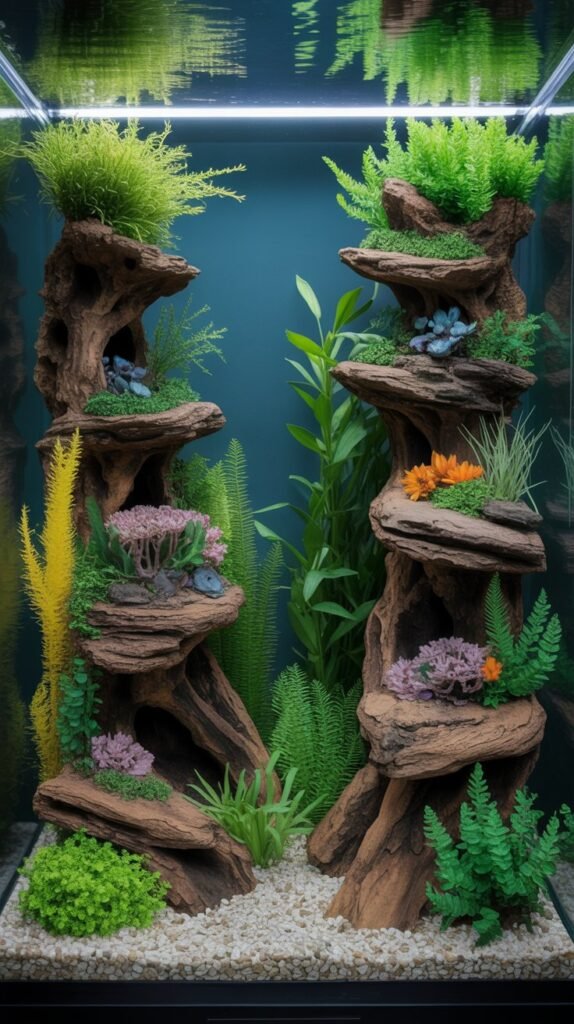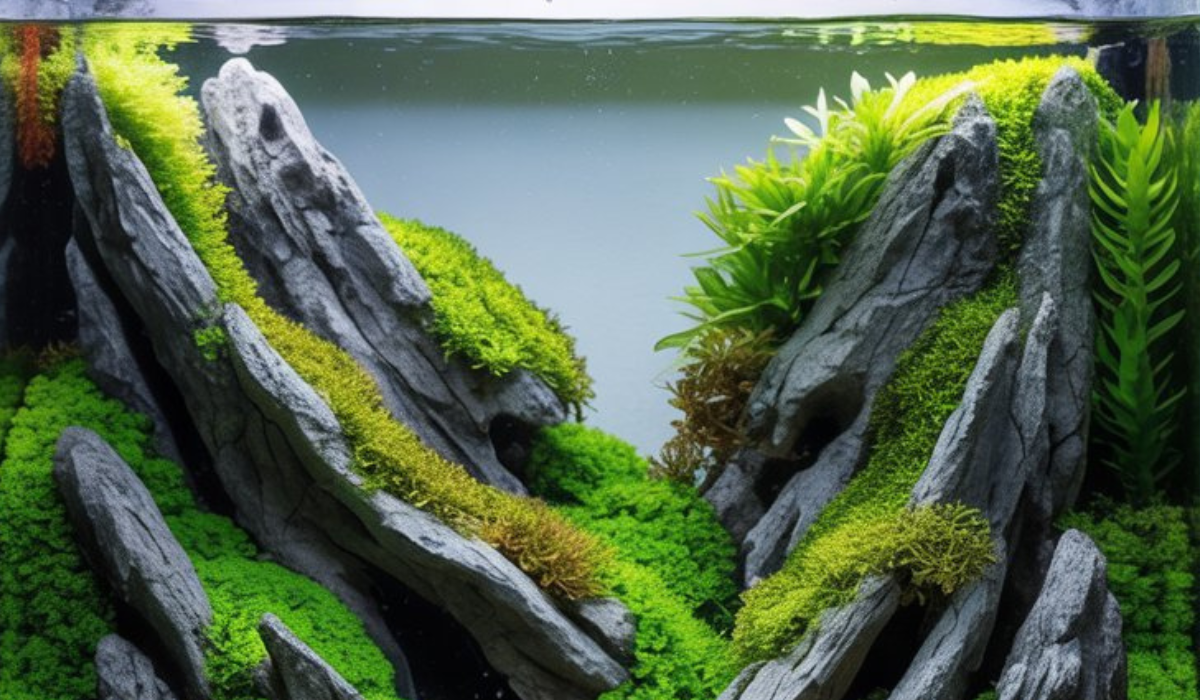Aquarium keeping has evolved far beyond simply placing fish in a tank. Today, aquariums are living artworks—carefully crafted ecosystems that blend creativity with natural beauty. At the core of every visually striking aquascape lies the hardscape. The hardscape aquarium concept focuses on building the structural foundation of the layout using rocks, driftwood, and substrate. These elements shape the entire design, guide plant placement, create depth, and establish a natural environment for your aquatic life.
If you’ve ever admired breathtaking aquascapes and wondered how aquarists achieve such beauty, the answer lies in mastering the hardscape. This comprehensive guide explores everything about hardscape aquarium design, from materials, layout styles, and techniques to tips, mistakes to avoid, and maintenance.
What Is a Hardscape Aquarium?
A hardscape aquarium is an aquascape where the design relies heavily on non-living decorative elements such as:
- Rocks
- Driftwood
- Substrate
- Branches
- Sand
- Soil
- Background stones
The hardscape forms the backbone of the aquarium and sets the overall structure of the layout. Plants and fish are added later, but the visual flow, height, depth, and balance originate from the hardscape.
A strong hardscape is essential in aquascaping styles such as:
- Iwagumi (rock-focused layouts)
- Nature aquarium
- Diorama style
- Mountain range layouts
- Jungle aquascapes
- River and canyon scapes
In these styles, the hardscape defines the scene—appearing as mountains, cliffs, forests, root networks, caves, or riverbeds.
Importance of Hardscape in Aquascaping

Hardscape elements do more than look attractive; they influence the stability and functionality of the aquarium ecosystem. Here’s why they matter:
1. Structural Foundation
The hardscape provides physical structure and shape. It supports substrate slopes and prevents landslides, especially in tanks with digging fish.
2. Visual Appeal
Rocks, wood, and substrate textures give the aquarium character, contrast, and beauty.
3. Depth and Perspective
Hardscape placement determines how deep or wide the aquarium appears. Proper layering makes small tanks look bigger.
4. Natural Habitat Creation
Many fish thrive in environments with rocks, caves, and wood—just like their wild habitats.
5. Plant Placement
Rocks and driftwood offer anchoring points for moss, epiphyte plants, and ground covers.
6. Aquascape Stability
A strong hardscape keeps the layout intact even during maintenance or replanting.
Essential Hardscape Materials
Aquarium hardscape materials can be divided into three main categories: rocks, wood, and substrate. Each plays a unique role in shaping your aquascape.
1. Rocks
Rocks are the most powerful tools in aquascaping. Their shape, color, and texture determine the theme and style of the layout.
Common Hardscape Rocks:
- Seiryu Stone – grey-blue with white veins; ideal for Iwagumi
- Dragon Stone (Ohko Rock) – brown, textured, and easy to break
- Ryuoh Stone – rugged, dramatic, volcanic appearance
- Lava Rock – lightweight, porous, good for bacteria
- Petrified Wood – brown, layered, wood-like appearance
- Manten Stone – premium, richly textured rock
- Pagoda Stone – layered surface perfect for mountain scenes
Choosing Rocks for Hardscape
Consider:
- Color harmony
- Texture
- Stone size variety
- Water chemistry impact
Some rocks increase pH or KH, so testing is essential.
2. Driftwood
Driftwood brings character and natural beauty to hardscape aquariums. Its organic shapes create flow and direction.
Popular Aquarium Woods:
- Spider Wood – twisted branches, great for jungle themes
- Manzanita Wood – smooth and branching
- Mopani Wood – dense, dual-toned
- Cholla Wood – porous and ideal for shrimp
- Bogwood – natural and heavy
Why Driftwood Is Important
- Provides hiding places
- Anchors plant roots
- Releases beneficial tannins
- Mimics river and forest habitats
3. Substrate
Substrate forms the base layer of your hardscape. It influences:
- Plant growth
- Tank stability
- Aesthetic appearance
Common Types of Substrate:
- Aquarium soil (nutrient-rich for planted tanks)
- Sand (ideal for river or desert themes)
- Gravel
- Powder soil (for carpet plants)
Substrate slopes are essential for depth and perspective.
Hardscape Aquarium Layout Styles

Different aquascaping styles use hardscape materials in distinct ways. Let’s explore the most popular ones.
1. Iwagumi Layout
A minimalist, rock-centered design originating from Japan. It uses a specific arrangement of stones:
- Oyaishi – main stone
- Fukuishi – secondary stone
- Soeishi – supporting stones
- Suteishi – small accent stones
This style symbolizes nature’s simplicity and balance.
2. Nature Aquarium Style
Introduced by Takashi Amano, this style mimics natural landscapes such as:
- Forests
- Hillsides
- Mountains
- Valleys
A balance of wood, rocks, and plants creates a realistic, harmonious layout.
3. Diorama or Mountain Range Aquascape
Uses dramatic stones to resemble:
- Rocky mountains
- Cliffs
- Canyons
- River valleys
This style often includes strong slopes and high focal points.
4. Jungle Style Aquascape
Driftwood plays a major role. Features include:
- Dense plants
- Twisted roots
- Overgrown appearance
- Chaotic but natural beauty
5. Island Style Aquascape
A central island of rocks or wood surrounded by open substrate. Great for beginner aquascapers.
6. River Style Layout
Smooth stones and sand create a natural riverbed look. Perfect for active fish like loaches and tetras.
How to Design the Perfect Hardscape Aquarium
Designing a successful hardscape requires planning, creativity, and understanding of basic composition rules.
1. Visual Focal Points
Every great aquascape has a focal point. Use:
- The Golden Ratio (1:1.618)
- The Rule of Thirds
Place your main stone or main driftwood piece slightly off-center.
2. Layering and Depth
Place larger stones/wood near the front or focal area, and smaller pieces in the background to create a sense of scale.
3. Create Natural Flow
Use the direction of rocks or wood to guide the viewer’s eye across the aquarium. Flow improves visual harmony.
4. Build Substrate Slopes
Front: shallow
Back: deeper
This creates depth and allows better plant growth.
5. Select Matching Materials
Avoid mixing too many rock types. Stick to:
- One type of stone
- One type of driftwood
This maintains consistency.
6. Stability Is Essential
Use:
- Superglue
- Epoxy putty
- Plastic anchors
These strengthen rock structures and prevent collapses.
7. Consider Fish Movement
Leave enough swimming space for fish. Certain species need caves, while others prefer open water.
8. Dry-Run Layout
Always build your hardscape outside the tank first. Adjust until satisfied.
How to Prepare Hardscape Materials

Preparation ensures safety and longevity.
1. Cleaning Rocks
- Scrub with a brush
- Rinse thoroughly
- Test for pH changes by soaking overnight
2. Preparing Driftwood
- Boil to remove tannins and parasites
- Soak to prevent floating
- Clean crevices thoroughly
3. Substrate Setup
- Rinse gravel or sand
- Create slopes early
- Place barriers if necessary
Plants That Work Well With Hardscape Aquariums
A hardscape aquarium often includes plants that complement rocks and wood.
Epiphyte Plants (attach to hardscape):
- Anubias
- Java Fern
- Bucephalandra
- Bolbitis
- Moss species
Foreground Carpets:
- Monte Carlo
- Dwarf Hairgrass
- Glossostigma
Background Plants:
- Rotala
- Ludwigia
- Vallisneria
Plants soften the hard edges and enhance the natural feel.
Fish Suitable for Hardscape Aquariums
The ideal fish depends on your layout style.
For Iwagumi or minimalist scapes
- Neon Tetra
- Ember Tetra
- Harlequin Rasbora
- Cherry Shrimp
For jungle-style scapes
- Gourami
- Angelfish
- Rasboras
For river layouts
- Loaches
- Corydoras
- Danios
Avoid large or destructive fish that may damage the hardscape.
Maintenance of Hardscape Aquariums
A well-designed hardscape requires minimal upkeep.
1. Algae Management
Algae tends to grow on rocks and wood. Control through:
- Proper lighting
- Balanced nutrients
- Amano shrimp
- Nerite snails
2. Water Changes
Clean water keeps your layout healthy and prevents algae buildup.
3. Avoid Disrupting the Hardscape
Once installed, do not frequently move rocks or driftwood.
4. Trim Plants Regularly
Overgrown plants can hide the hardscape.
Common Mistakes to Avoid
Avoid these pitfalls for best results:
1. Using Too Many Hardscape Types
Stick to one rock type and one wood type for harmony.
2. No Focal Point
A layout without direction looks messy.
3. Steep Slopes Without Support
Use stones, wood, or mesh to reinforce slopes.
4. Scaling Issues
Large rocks in a small tank look unnatural.
5. Ignoring Water Chemistry
Some rocks alter pH—always test first.
6. Poor Balance Between Hardscape and Plants
Plants should enhance the layout, not overwhelm it.
Advantages of Hardscape Aquariums
1. Long-Lasting Beauty
Hardscape elements last longer than plants, retaining the tank’s structure.
2. Easier to Maintain
Less pruning compared to full plant tanks.
3. Natural Behavior in Fish
Caves and crevices reduce stress and promote natural behaviors.
4. Versatile Design Options
From minimalistic to dramatic mountain layouts.
5. Suitable for Beginners
Once the hardscape is set correctly, maintenance is simple.
Conclusion
A hardscape aquarium is the foundation of a stunning aquascape. With the right combination of rocks, driftwood, and substrate—and a thoughtful design approach—you can transform your aquarium into a living piece of art. Hardscape gives structure, depth, beauty, and function. From choosing materials to following layout principles, mastering hardscaping will elevate your aquascaping skills and bring a natural, captivating look to your aquarium.
Whether you’re building a dramatic mountain range or a peaceful forest stream scene, hardscape is the key to a professional and long-lasting aquascape.
FAQs About Hardscape Aquarium
Q1: What is the best rock for hardscape aquariums?
Dragon Stone, Seiryu Stone, Lava Rock, and Ryuoh Stone are popular because they offer great texture and natural appearance.
Q2: Can I use outdoor rocks in my aquarium?
Yes, but only after cleaning, boiling (if safe), and testing for pH changes.
Q3: Do all rocks affect water chemistry?
No. Some rocks like Seiryu raise pH and KH, while Dragon Stone and Lava Rock are inert.
Q4: How do I keep hardscape stable?
Use aquarium-safe glue, epoxy, or support stones to reinforce the structure.
Q5: Can driftwood cause water discoloration?
Yes, driftwood releases tannins, which can turn the water brown. Boiling helps reduce this.
Q6: How much hardscape material do I need?
Typically, hardscape makes up 30–50% of the tank’s visible layout.
Q7: Can hardscape aquariums work without plants?
Yes. Hardscape-only or minimal-plant aquariums are popular and visually striking.
Q8: Is a hardscape aquarium good for beginners?
Absolutely. Once the layout is set, maintenance is minimal and predictable.

